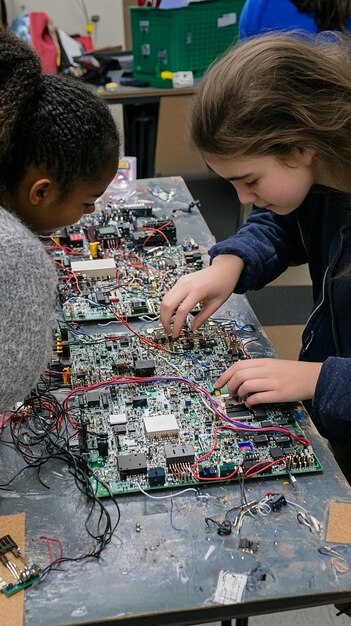Alternative Education Pathways: Trade Schools & Vocational Programs in US

Exploring alternative education pathways: trade schools and vocational programs in the US reveals a dynamic landscape offering specialized training and direct career entry, providing viable and often faster routes to economic independence beyond traditional four-year degrees.
In a rapidly evolving job market, the traditional four-year university path is no longer the sole, or even always the best, route to a successful career. For an increasing number of Americans, alternative education pathways: trade schools and vocational programs in the US are emerging as powerful accelerators to professional fulfillment and financial stability. These programs offer focused, hands-on training tailored to specific industries, preparing individuals with the practical skills demanded by employers today. This comprehensive exploration delves into the nuances of these vital educational options, highlighting their benefits, challenges, and the diverse opportunities they unlock.
The Shifting Landscape of Education and Employment
The perception of education, particularly in the United States, has undergone a significant transformation over the past few decades. For a long time, a bachelor’s degree from a four-year college was widely considered the quintessential gateway to a prosperous career. However, economic shifts, rising tuition costs, and the increasing demand for skilled trades have significantly broadened the conversation around viable educational alternatives.
This shift isn’t merely anecdotal; it is reflected in workforce data and employer needs. Industries across the spectrum, from healthcare to manufacturing and technology, face a persistent shortage of skilled professionals. This demand creates fertile ground for those who choose a path focused on acquiring specific, applicable skills rather than a broad academic overview. The narrative is moving from “college or bust” to a more nuanced understanding of diverse educational journeys, each with its own merits.
The Rise of Skills-Based Economies
Modern economies are increasingly skills-based, prioritizing practical competencies over theoretical knowledge in many sectors. This emphasis means that individuals who can demonstrate proficiency in specific trades or technical areas are highly sought after. Employers often find that graduates from trade schools or vocational programs are job-ready, requiring less on-the-job training and contributing immediately to productivity.
- Reduced student debt burden compared to four-year universities.
- Faster entry into the workforce, often within months or a couple of years.
- High demand for skilled trades leading to competitive salaries.
- Hands-on learning environments that cater to various learning styles.
Furthermore, the agility of vocational programs allows them to adapt quickly to industry changes, integrating new technologies and techniques into their curricula far more rapidly than larger, more bureaucratic academic institutions. This responsiveness ensures that students are equipped with the most current and relevant skills, making them incredibly attractive to employers in fast-evolving fields.
In essence, the changing landscape underscores a fundamental truth: education is about acquiring value, and that value can come in many forms. For many, the direct, practical, and often more affordable route of trade schools and vocational programs offers a compelling argument for vocational education in the 21st century.
Understanding Trade Schools and Vocational Programs
Trade schools, also often referred to as vocational schools or technical colleges, are post-secondary institutions specifically designed to provide students with the practical skills and knowledge needed to enter a particular trade or occupation. Unlike traditional colleges that offer broad academic curricula, these institutions focus on hands-on training and direct preparation for a specific career path.
The scope of programs offered by trade schools is incredibly diverse, spanning numerous industries. From healthcare and information technology to construction and culinary arts, these programs cater to a wide array of interests and professional aspirations. The curriculum is typically condensed and highly practical, emphasizing competency and direct application of learned skills.
Types of Programs and Certifications
Vocational programs generally lead to certificates, diplomas, or associate degrees, rather than bachelor’s or master’s degrees. These credentials signify proficiency in a specific trade or technical area and are highly valued by employers looking for job-ready candidates.
- Certificates: Short-term programs (a few months to a year) focused on specific, entry-level skills. Examples include certified nursing assistant (CNA) or welding.
- Diplomas: Slightly longer programs (one to two years) offering a more comprehensive skill set within a trade. Examples include automotive technician or paralegal studies.
- Associate Degrees (A.A.S. or A.O.S.): Two-year programs that combine technical training with some general education courses, providing a broader foundation. Examples include registered nurse (RN) or electrical engineering technology.
These distinctions are important because they impact program length, cost, and the types of roles graduates are prepared for. However, all these credentials share a common goal: direct entry into the workforce with marketable skills. The focus remains squarely on practical application, often achieved through extensive lab work, apprenticeships, and real-world simulations.
The structured and intensive nature of these programs ensures that students are not just learning theories but are actively engaged in the work they will perform on the job. This immersive approach is a hallmark of trade and vocational education, setting it apart from more traditional academic settings.
The Advantages of Choosing a Vocational Path
The decision to pursue an alternative education pathway, such as a trade school or vocational program, comes with a myriad of compelling advantages. These benefits often address the very concerns that lead many to question the traditional four-year college model, including cost, time to completion, and direct job prospects.
One of the most immediate and significant benefits is the reduced financial burden. Tuition for trade schools is typically considerably lower than that of four-year universities. This affordability, combined with shorter program durations, means less accrued debt and a faster return on investment through employment.
Financial Savings and Quicker Entry into the Workforce
The cost effectiveness extends beyond tuition. Students spend less time out of the workforce, earning money sooner rather than accumulating debt. This accelerates financial independence and allows individuals to start building their careers and savings earlier. Many programs also offer flexible schedules, allowing students to work part-time while studying.
- Lower tuition and fees compared to traditional bachelor’s degrees.
- Opportunities for scholarships and financial aid specifically for vocational training.
- Ability to earn a living wage much sooner after graduation.
- Reduced living expenses due to shorter program durations.
Furthermore, the direct career-focused nature of these programs means that graduates are often highly sought after by employers. Industries are actively seeking individuals with specific, hands-on skills, and vocational training provides exactly that. This demand can translate into better job security and opportunities for advancement.

The curriculum’s practical focus ensures that graduates are not just theoretically prepared but are truly job-ready, minimizing the need for extensive on-the-job training. This makes them valuable assets from day one, often leading to competitive starting salaries and quick integration into professional roles.
Ultimately, the advantages of vocational education extend far beyond mere financial savings. They encompass a fast-tracked approach to career development, a direct response to market demands, and a highly practical learning experience that benefits both the individual and the employers they serve.
Key Industries Thriving on Vocational Training
Vocational training serves as the backbone for numerous critical industries, fueling their growth and innovation with a steady supply of skilled professionals. While the perception of trade jobs often conjures images of construction or mechanics, the reality is far broader, encompassing sectors that are modern, high-tech, and rapidly expanding.
Healthcare is a prime example. Beyond doctors and nurses with traditional degrees, the healthcare system relies heavily on a vast array of vocational professionals: medical assistants, dental hygienists, phlebotomists, surgical technologists, and certified nursing assistants (CNAs). These roles are essential for patient care and the smooth operation of medical facilities, and they are almost exclusively trained through vocational programs.
Growing Sectors and In-Demand Trades
Another immensely important area is the technology sector. While software engineers often come from four-year universities, critical roles supporting IT infrastructure, cybersecurity, and network administration are frequently filled by graduates of vocational tech programs. These roles are front-line defenders of digital systems and facilitators of modern connectivity.
- Manufacturing and Advanced Automation: Technicians for robotics, CNC machining, and automated systems.
- Renewable Energy: Solar panel installers, wind turbine technicians, and energy efficiency specialists.
- Skilled Trades (Construction & Maintenance): Electricians, plumbers, HVAC technicians, welders, and carpenters.
- Automotive and Transportation: Auto mechanics, diesel technicians, and aviation maintenance specialists.
The demand in these sectors isn’t just steady; it’s growing. As infrastructure ages, technology advances, and the population shifts, the need for skilled tradespeople becomes increasingly acute. This demand translates into excellent job prospects, competitive wages, and often, opportunities for entrepreneurship for those with the right skills and drive.
Even fields like culinary arts and cosmetology, often seen as traditional trades, have evolved, demanding sophisticated skills in business management, sanitation, and artistic expression, all of which are meticulously taught in specialized vocational schools. These industries prove that vocational training is not just about manual labor but about combining precision, artistry, and technical knowledge to deliver high-quality services.
Navigating the Application and Enrollment Process
Embarking on an alternative education pathway at a trade school or vocational program involves a distinct application and enrollment process compared to traditional universities. While generally less complex than applying to a four-year institution, it still requires careful planning and attention to detail. Understanding these steps is crucial for a smooth transition into vocational training.
The first step typically involves researching and selecting the right program and institution. This means identifying a trade or skill that aligns with your interests and career goals, then finding accredited schools that offer high-quality programs in that area. Accreditation is vital, as it ensures the program meets specific quality standards and that your credentials will be recognized by employers.
Admission Requirements and Financial Aid
Admission requirements for trade schools are often more flexible and less stringent than those for four-year colleges. While a high school diploma or GED is usually a prerequisite, standardized test scores (like the SAT or ACT) are rarely required. Instead, emphasis is placed on an applicant’s genuine interest, aptitude for the trade, and sometimes, a basic entrance exam or interview.
- High school diploma or GED certificate.
- Completion of a program-specific entrance exam or aptitude test.
- Personal interview to assess motivation and suitability for the trade.
- Submission of an application form and relevant transcripts.
Financial aid options are also available for many vocational programs. Prospective students should complete the Free Application for Federal Student Aid (FAFSA) to determine eligibility for federal grants and loans. Additionally, many trade schools offer scholarships unique to their programs, and industry associations often provide funding for aspiring professionals in their fields.
It’s also worth exploring employer-sponsored training programs or scholarships offered by local businesses that are actively seeking to fill skilled labor gaps. These opportunities can significantly reduce the out-of-pocket costs of vocational training, making it even more accessible. The key is proactive research and communication with the admissions and financial aid offices of prospective schools.

The application journey for trade schools is designed to be straightforward, prioritizing genuine interest and practical aptitude. By thoroughly researching programs, understanding admission criteria, and exploring all available financial aid, individuals can effectively navigate their path into these highly rewarding educational opportunities.
Challenges and Considerations for Vocational Study
While alternative education pathways: trade schools and vocational programs in the US offer significant advantages, it is equally important to acknowledge and consider the potential challenges. A comprehensive understanding of these aspects ensures that prospective students can make informed decisions and prepare adequately for their chosen path.
One common challenge involves the perception of vocational education. Despite growing recognition of its value, a societal bias sometimes persists, prioritizing traditional four-year degrees. This can, at times, affect how vocational graduates are viewed, though this sentiment is rapidly diminishing as the demand for skilled trades grows.
Program Intensity and Career Path Limitations
The intensive nature of vocational programs can also be a challenge. Because they are designed for rapid skill acquisition and direct job placement, the curriculum is often condensed and moves at a fast pace. This requires a high level of dedication, discipline, and the ability to absorb practical information quickly.
- Rapid pace of learning and high demands for practical application.
- Potential for limited upward mobility in some highly specialized roles without further education or certification.
- Ongoing need for continuing education and certifications to stay current in evolving industries.
- Varying quality of programs, necessitating thorough research into accreditation and employer connections.
Another consideration is the potential for career path limitations in very narrow specializations. While vocational training excels at providing job-specific skills, some roles may have a more defined ceiling for advancement unless further certifications or different educational experiences are pursued. However, many trades offer clear paths for progression, leadership, and even entrepreneurship.
Furthermore, staying current with industry advancements is crucial. Many trades are dynamic, with new technologies and techniques emerging regularly. Vocational graduates must be prepared for a lifelong commitment to learning, often through continuing education courses, certifications, and professional development to maintain their competitive edge and ensure long-term career viability.
Ultimately, by acknowledging these challenges and actively planning for them, students can maximize the benefits of vocational training and build a robust, sustainable career. The key lies in choosing accredited programs, understanding the commitment required, and embracing ongoing professional development.
Future Outlook: Apprenticeships, Technology, and Policy
The future of alternative education pathways: trade schools and vocational programs in the US looks incredibly promising, driven by evolving workforce needs, technological advancements, and supportive policy shifts. This dynamic evolution suggests an even greater role for vocational training in shaping the American labor market.
A significant trend is the resurgence of apprenticeships. Traditionally a core component of skilled trades, modern apprenticeships are expanding beyond their conventional boundaries, now encompassing fields like IT, healthcare, and advanced manufacturing. These earn-while-you-learn models provide invaluable on-the-job training combined with structured classroom instruction, bridging the gap between education and employment.
Embracing Innovation and Policy Support
Technology will continue to play a transformative role. Virtual reality (VR) and augmented reality (AR) are increasingly being used in vocational training to simulate complex tasks and dangerous environments, allowing students to gain hands-on experience without real-world risks. Automation, artificial intelligence, and sophisticated machinery require a new breed of technicians skilled in programming, maintenance, and diagnostics.
- Growth of hybrid learning models combining online coursework with hands-on labs.
- Increased integration of soft skills training (problem-solving, communication, teamwork) into technical curricula.
- Strategic partnerships between educational institutions and industry leaders to align curricula with workforce needs.
- Government initiatives and funding dedicated to strengthening vocational training and apprenticeships.
From a policy perspective, there’s growing bipartisan support for investing in vocational education. Policymakers recognize the critical role these programs play in addressing skills gaps, fostering economic competitiveness, and providing accessible pathways to middle-class jobs. This translates into increased funding, incentives for employers, and frameworks that streamline the transition from education to employment.
The future also involves greater flexibility and pathways between vocational training and higher education. Articulation agreements are becoming more common, allowing vocational credits to transfer to community colleges or even four-year universities, providing graduates with options for continued academic advancement if they choose.
In essence, the landscape for vocational education is one of growth, innovation, and increasing recognition. As technology reshapes industries and the demand for specialized skills continues to rise, trade schools and vocational programs are poised to become even more integral to the nation’s educational and economic future.
| Key Aspect | Brief Description |
|---|---|
| ⏱️ Timeframe | Typically 6 months to 2 years, much shorter than traditional degrees. |
| 💰 Cost Efficiency | Significantly lower tuition and fees, reducing student debt. |
| 🛠️ Skill Focus | Hands-on training tailored for specific in-demand trades and industries. |
| 📈 Job Market | High demand for vocational skills leads to strong employment prospects. |
Frequently Asked Questions About Alternative Education Pathways
▼
The primary distinction lies in their focus. Trade schools offer specialized, hands-on training for specific occupations, preparing students for direct entry into the workforce. Traditional universities provide broad academic education, culminating in degrees that emphasize theoretical knowledge and critical thinking across various disciplines.
▼
Yes, many reputable vocational programs are accredited. Accreditation is crucial because it signifies that the program meets recognized standards of quality and excellence. It ensures that your earned credentials will be recognized by employers and, if applicable, allows credits to transfer to other educational institutions.
▼
A wide variety of in-demand careers are accessible through trade school education. Common pathways include electricians, plumbers, HVAC technicians, automotive mechanics, medical assistants, dental hygienists, welders, culinary arts professionals, IT support specialists, and many roles in advanced manufacturing and renewable energy.
▼
Absolutely. Students attending accredited trade schools are often eligible for federal financial aid programs, including Pell Grants and federal student loans. Many vocational schools also offer institutional scholarships, and there are numerous private scholarships and grants specifically for students pursuing vocational training.
▼
The duration of trade school programs varies significantly based on the specific trade and the credential sought. Many certificate programs can be completed in as little as six months to a year, while diploma programs may take one to two years. Associate’s degree programs, which combine technical training with general education, typically require two years of study.
Conclusion
In rethinking success in the modern economy, alternative education pathways: trade schools and vocational programs in the US present a compelling and often superior choice for many individuals. They offer a direct, cost-effective, and highly efficient route to obtaining in-demand skills, leading to faster workforce entry and rewarding careers. As societal perceptions evolve and industry needs continue to shift, vocational education stands as a vital pillar of the American educational landscape, empowering individuals and fostering a skilled workforce essential for national growth and prosperity.





